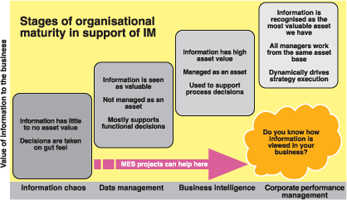
The implementation of manufacturing execution system (MES) technology is seen by many as an indispensable performance enhancement elixir.
Specifying and selecting an MES.
Keywords: [automation, architecture, asset, BIDAT, business intelligence, business process, competitive advantage, compliance, enterprise architecture, ERP, event, forecasting, integration, ISA95, inventory, manufacturing execution system, material tracking, MES, metal accounting, mineral processing, modelling, partnership, scheduling, production planning, S88, selection, SOA, strategy]
Abstract
With today’s competitive manufacturing environment, companies must look at which technology can help them deliver more quickly, cheaply and efficiently to meet their customer’s demands. MES software aims to provide operator support, production scheduling, genealogy tracking capabilities and accurate, real-time visibility into production performance.
As a result such software could deliver the following benefits to an organisation:
* Reduction of errors (and thus a reduction of waste and rework).
* Easier location of the causes of problems.
* Reduction of manual entry time.
* Reduced cycle-time (and thus increased yield and throughput).
* Efficient use of equipment.
* Improved planning and streamlined schedules.
* Reduced cost of regulatory compliance.
There is no standard tick-list for deciding whether a business needs MES software. The key to a successful software implementation is making sure the requirements are defined and what is important to the enterprise before selecting which software would best meet its business objectives, and therefore 'Understanding the key elements on successfully specifying and selecting a MES system for the mineral industry' is very important.
Introduction
The implementation of manufacturing execution system (MES) technology is seen by many as an indispensable performance enhancement elixir. It is the next big thing after ERP; something you must have to be competitive. Yet the irony of the 'IT paradox' also holds true in this case. More elaborate technology does not equate to better business performance; much more is needed. It is equally true that breakthrough performance within an industry is not sustainable without a solid technology platform.

MES technology differentiates itself from commercial business process management systems through its ability to enhance production output. It is not designed to cut costs. It is, however, designed to help businesses deliver increased output through direct control over execution of production processes. It often links up with existing automation systems, thereby expanding the level of direct control within the grasp of management. Correctly deployed, MES technology can provide a unique and sustainable competitive advantage.
A common theme emerges from both these considerations. MES technology enables access to information that allows the business to know what is happening in the manufacturing processes as it happens. Whether its management will act upon this information is a function of how much value they attach to it. This largely determines the impact the investment will have on the business, more so than the level of business process automation it enables.
The challenge of selecting an MES solution for the mineral processing industry therefore hinges on two key concepts:
* Understanding the factors contributing to achievement of business objectives within the industry (and how these may be unique to your business).
* The state of readiness within the industry (and within your business) to deal with the amount and characteristics of the information it will provide in answer to these questions.
This paper examines the influence of these two factors on the MES selection process. In addition, it also looks at the importance of architecture and where the MES fits into the enterprise architecture. This predisposes the MES towards key functionalities that enable its role within such a composite architecture. Finally, it looks at how the implementation process can affect the choice of partners both internal and external to the business, and hence the choice of MES product.
Continued on the web
For the complete article visit www.instrumentation.co.za/+C9210

© Technews Publishing (Pty) Ltd | All Rights Reserved